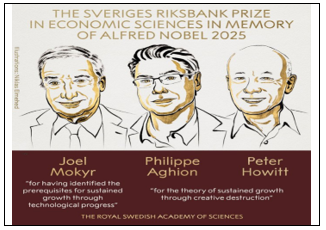Syllabus:
GS-3: Inclusive growth and issues arising from it

Context: The Royal Swedish Academy of Sciences awarded the Nobel Prize in Economics, to Joel Mokyr, Philippe Aghion and Peter Howitt for having explained innovation-driven economic growth.
More on the News
- The economics prize is formally known as the Sveriges Riksbank Prize in Economic Sciences in Memory of Alfred Nobel.
- The award comes with a prize money of 11 million Swedish kronor (Rs 10.25 crore); half the prize money has been awarded to Mokyr, and the remaining half will be shared between Aghion and Howitt.
Key Discoveries
• Mokyr’s contribution:
- Advances Require Science and Skills: Real progress happens when societies merge practical know-how with scientific understanding, making possible game-changing innovations like improved engines and steel.
- Growth Needs Societal Openness: The full benefits of technological change only emerge if societies welcome new ideas, tolerate disruption, and adapt legal and social structures accordingly.
- Creative Destruction is Essential: Lasting economic growth depends on “creative destruction,” where outdated businesses and ways are replaced by new, superior methods ensuring a constant renewal of economic activity.
- Resistance Hinders Progress: Societies unwilling to accept disruption—such as resisting new machines risk stagnation and losing comparative advantage.
- Institutions Matter: The creation of flexible and responsive institutions helps manage conflict from change and maintains an environment favoring innovation and economic dynamism.
• Aghion & Howitt’s contribution:
- Shared Focus, Different Approach: Aghion & Howitt addressed the same question as earlier economists, how technological advancement drives sustained economic growth, but by studying the modern economy rather than historical data.
- Micro-Level Upheaval: They found that national-level stable growth masks significant upheaval at the firm level, characterized by high rates of company entry, exit, job creation, and job destruction annually.
- Macro-Level Stability from Upheaval: Their 1992 mathematical model demonstrated how this seemingly disruptive firm-level creative destruction provides the fundamental basis for stable macroeconomic growth.
- Innovation Incentives: The model features companies using patents to gain temporary monopolies and profits. These profits fund production, but the patents also incentivize competitors to invest in R&D to create the next superior innovation, driving continuous progress.
- Interconnected Markets (General Equilibrium): A key feature was the integration of production, R&D investment, financial markets, and household savings. The model was the first macroeconomic framework for creative destruction to achieve “general equilibrium”, where all these linked markets are in balance.

